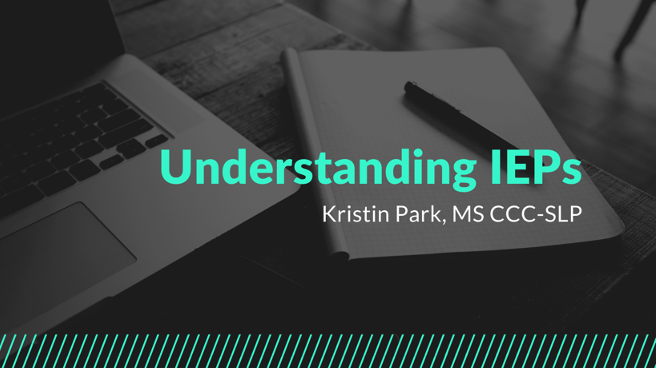Understanding IEP Goals
Kristin Park, MS CCC-SLP A while ago, I wrote a blog post about

By: admin | February 15, 2021
Understanding IEPs
Kristin Park, MS CCC-SLP
Parents often have many questions when their child first qualifies for an IEP. The eligibility determination process can be lengthy, complicated, and somewhat confusing. IEP documents themselves can often be pages upon pages of tables, checkboxes, and signature lines. In this blog, I explain the basics of an IEP and what to expect as you read through one.
What is an IEP?
IEP stands for Individualized Education Plan. An IEP is a legal document or “plan” created by a school district that outlines the special education, supports, and services a student will need to make progress and thrive in school. IEPs are highly individualized (as the name suggests) and are tailored to meet each student’s unique needs. Public schools are required to create and implement IEPs for students with disabilities as per the Individuals with Disabilities Education Act (IDEA), a federal law that entitles all children with learning disabilities a free, appropriate education.
Who is eligible for an IEP?
Any student who is identified as having a disability that adversely affects their educational performance may be eligible for an IEP. There are several categories of special education that a student may fall under which require IEPs. These categories include:
Public schools are required by IDEA to implement IEPs for eligible students. This includes charter schools as well. Private schools do not create IEPs – rather, students who require specialized services may have what’s called a Service Plan (or Individual Service Plan).
IEPs versus 504 Plans
In some cases, students may receive services outlined in a 504 Plan rather than an IEP. The name “504 Plan” refers to Section 504 of the Rehabilitation Act of 1973, which is a federal civil rights law to stop discrimination against people with disabilities. Section 504 has a broader definition of a disability than IDEA: It says a disability must substantially limit one or more basic life activities. This can include learning, reading, communicating, and thinking. Therefore, a child who doesn’t qualify for an IEP may still qualify for a 504 Plan. Rather than providing special education and related services, a 504 Plan identifies how the school will modify the student’s environment to remove barriers and enable students to learn alongside peers.
Sections of an IEP
The exact formatting of an IEP may vary by state or school, depending on the documentation program used. The Department of Education requires the following information to be included in an IEP:
â— Student Demographics and IEP Team
â—‹ The first page lists the child’s name, age, date of birth, grade, and other details. It also includes a rundown of the IEP team.
â— Present Levels of Academic Performanc
â—‹ This section describes a student’s current abilities, skills, challenges, and strengths. Input is gathered from various sources including teachers, parents, and relevant professionals. Social skills and behavioral concerns may also be described here.
â— Annual Goals
â—‹ These are the functional, measurable goals and objectives that the student’s IEP team will monitor throughout the IEP cycle (typically one school year). Annual goals are designed to be reasonably achievable and are often broken down into short-term objectives.
â— Progress Reporting
â—‹ Each annual goal will be measured and progress will be reported in this section. Progress is typically reported quarterly, around the same time as school report cards are generated. This section should clearly outline how progress will be measured, how often, and by whom.
â— Services
â—‹ In this section, the IEP describes what special education services the student will receive and at what frequencies. It also states whether the student qualifies for any services outside of the regular school year such as Extended School Year (ESY). For older students, a transition plan to prepare for post-academia will be included in this section.
â— Supplementary Aids and Services
â—‹ Any special accommodations that will assist the student will be listed in this section. Accommodations can include things such as preferential seating or extended test time. Special modifications may also be included, such as less homework. This section will also include information about any assistive technology the child needs.

Kristin Park, MS CCC-SLP A while ago, I wrote a blog post about
By: admin | January 19, 2022
